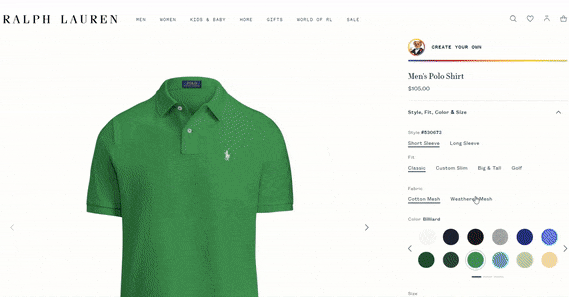oxygen domain was triggered too early. This is usually an indicator for some code in the plugin or theme running too early. Translations should be loaded at the init action or later. Please see Debugging in WordPress for more information. (This message was added in version 6.7.0.) in /var/www/wp-includes/functions.php on line 6121
According to most researchers, the next decade will be the age of the visual economy. While the definition of the visual economy has its roots in fine arts, the coming years will see more brands, marketers, and everyone in-between rely on visual designs and experiences to stand out from the crowd.
In visual arts, the concept of a visual economy refers to simplifying a composition by eliminating all non-essential elements from a scene — to highlight the essence of a form.
The philosophy spans the entire gamut of human civilization – influencing ancient cultures and the famous European renaissance artists. Today, it often refers to a company’s ability to create a rich and engaging visual product experience across all digital channels, usually to improve conversion rates.
Ecommerce ventures are realizing the value that visual content plays in communicating a message, evoking an emotional response, and engaging their audience at every step of the interaction. In this blog, we’ll go a step further and explain why your visual experience design matters, what elements influence your visual product experience, and how you can improve your product visuals using the latest technologies.
Visual elements affect our perceptions. In visual design, the volume, quantity, and interactivity of the imagery make up the bulk of the user experience when browsing through a site. As the majority of shoppers make decisions based on perception, conversion rates depend much more on what we see than you may think.
In ecommerce, everything from the layout of the site to colors you use for your frames, banners, and other design elements will influence your customer’s perceptions. Even if you get all these elements correct, you may still struggle to convert customers if your visual product designer doesn’t highlight the right features (or captures the form) of your items.
Consider these stats:
Finally, the way we process information also affects our perception of a product. Online retailers have limited opportunity to create a lasting impression, making the visual product experience essential to ensuring you convert visitors into regular customers.
In the real world, consumers depend on all their senses when making a buying decision. Once they move online, what their eyes see becomes one of the biggest influences in their decision-making process. This isn’t necessarily a digital phenomenon, as marketers have relied on engaging visuals to sell products since the introduction of the Gutenberg press in the 15th century.
What’s more, according to researchers at MIT, we encode prior beliefs into the experience when forming new perceptions. Any flaw in your visual experience design runs the risk of failing simply because of an inherent bias that existed before a customer even arrived on your ecommerce site. To overcome these challenges, you need to ensure you match your customer’s expectations at every stage of their buying journey.
Product visuals on an ecommerce site have to address one key element: People judge almost everything by the way it looks.
Forming snap judgments is a big part of how we process information and helped us evolve into the intelligent and capable (but impulsive) beings we are today. Part of this psychology includes the aesthetic-usability effect. It describes the phenomena of how people add more value to items with prettier, more pleasing designs – compared to others that may function better.
In short, we’ll ignore some flaws in a product if it looks nicer than another, better-performing model. The same rule-of-thumb applies to today’s ecommerce sites and the visual content used. Applying the latest visual design principles, technologies, and interactive tools is a critical element to consider when improving your visual experience design.
The intent of visual design principles is to create a holistic perception of your product’s value. Unity is a key design criterion for not only your products but also the way you present them and how users can interact with your product visuals.
When setting up your product listings, you should consider the standard visual design principles for every aesthetic element on your site. Bringing all these elements together to build a cohesive whole may take years for a visual designer to master.
Visual product designers often list the following principles when asked what makes for a better visual product experience:
Now that you understand why visual product experience matters, let’s look at some additional tools you can use to drive your engagement and increase your conversions. In ecommerce, you should already be using high-resolution images, contrasting backdrops, and a consistent hierarchy of elements to provide the best online shopping experience.
To go even further with your visual experience design, consider these three tips.
Most online retailers may still think that allowing customers to customize their products is beyond their reach. The truth is most suppliers now provide these services since more consumers are making buying decisions based on this capability.
While product personalization has been growing as a trend in the past, the retail industry is now filled with suppliers that allow customers to co-design products in a variety of ways. Product customization gives customers a curated set of options to modify certain elements of an item before making a purchase.
Depending on the product, customers can change fabrics, colors, materials, or patterns used in the design. If you allow customers to customize a product, they’ll be willing to pay more, wait longer for the delivery, and still enjoy the experience. For any customization options you do provide, ensure customers can see the changes they make on the product visuals you use on the site to ensure you meet their immediate expectations.
For example, the experience of personalizing your favorite Ralph Lauren Polo takes product visualization to the next level. With this configurator, you’re able to choose from a range of colors, logos, monograms, and much more to make the polo truly one of a kind.

Via Ralph Lauren
Another way to improve your visual product experience is to include 3D product visualizations for all your goods. The advances in web browsers now allow you to use technologies like WebGL to deliver high-resolution, 3D models with accurate renderings for any product you list.
Including a 3D product visualization on your site can increase your conversion rate by as much as 30%. As customers can investigate how the product looks from different angles, a 3D rendering of your items provides them with higher confidence and a better experience when using your ecommerce site.
WebGL is now a common technology that allows sites to provide rich and engaging 3D models of their products. To make sure your visual product design can compete with other online retailers, you’ll need to include 3D product visualizations for your items.
Hydro Flask recently launched 3D product visualization for their line of custom water bottles. Check it out to see how you can rotate the bottle as well as zoom in and out to see every aspect of the product in greater detail.

Via Hydro Flask
Finally, you can use one of the latest technologies to wow customers and provide the next generation of interactivity. Using augmented reality in your product visualization design gives your customers a powerful, immersive experience that increases engagement by about 66%.
As the technology is also available on mobile devices, you can drive conversions by almost 11% with augmented reality (AR). AR allows customers to check how a piece of furniture would look in their own home or try on a piece of clothing virtually. Although many retailers still consider AR as an emerging technology, the latest capabilities will surprise even the most sophisticated customer by bridging the gap between the real and virtual worlds.
When you want to ensure you stand out from other online retailers, augmented reality is one of the latest trends that you need to include in your visual product experience.
ConfigureID is a product personalization and customization platform that allows you to drive your conversions with superior visual product experiences. When you need to elevate your site or brand beyond the mundane, ConfigureID enables you to deliver stunning visuals that engage your customers across any digital channel in your portfolio.
With a host of features available that support some of the biggest brands around the globe, ConfigureID is a product personalization platform of choice for 3D visualization, product customization, and now includes designing for augmented reality experiences.
To discuss your visual experience design with a team of dedicated professionals, contact ConfigureID to see what’s possible.